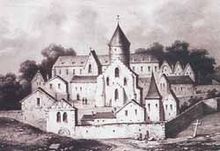Saint-Antoine-des-Champs
The Saint-Antoine-des-Champs Abbey , today's Hôpital Saint-Antoine in the 12th arrondissement of Paris, played an important role in the Middle Ages. It is the nucleus of the Faubourg Saint-Antoine .
history
Until the 12th century, the subsequent location of the abbey was marshland, which was irrigated by streams from the hills of Belleville and Ménilmontant . Only the old Roman road from Paris to Meaux and Melun (the extension of the later Rue Saint-Antoine ) crossed the area.
1198 had Fulko von Neuilly , the pastor of Saint-Baudile in Neuilly-sur-Marne and preacher of the Fourth Crusade , here at the expense of Pope Innocent III. build a small hermitage for women in a socially difficult situation. In 1204 the convent was converted into a Cistercian abbey and fortified, the moats were connected to the Seine by canals . Armed men defended the place under the command of the abbess, the Dame du Faubourg . The abbey church was consecrated to St. Anthony .
In 1229 King Ludwig IX. the monastery to the royal abbey (Abbaye Royale). The king's donations spread to the entire settlement that developed around the abbey. Numerous craftsmen settled here and still belonged to the Paris guilds . Gradually the swamps were drained and the area was then used for agriculture. The proximity of the Seine in turn allowed a permanent supply of wood, which led to the settlement of carpenters.
On August 18, 1239, Ludwig IX. exhibit within the abbey the crown of thorns that he had bought from Baldwin II , the Latin emperor of Constantinople , before he moved into Paris with the relic. In 1261 he confirmed a law of his predecessor Ludwig VI. , which banned pigs from roaming the city and only exempted pigs from the Saint-Antoine abbey from this ban - provided that they wore a bell with a cross on it so that they could be recognized.
In 1471 the abbey was owned by King Ludwig XI. a rare privilege granted: she was exempted from membership of the guilds. Relieved of high tax payments, many artisans settled near the abbey. The suburb was able to benefit from this regulation for more than 150 years.
In the middle of the 17th century, the abbey owned around 50 streets. The abbey itself could not accommodate more than 20 women.
In 1767, the architect Nicolas Lenoir added two wings to the parish building and at the same time built the Aligre district on a plot of land that had been left by the abbey, which was able to benefit from property speculation in this way . The law of February 13, 1790, with which the religious orders were dissolved, ushered in the end of the abbey.
By decree of February 11, 1791, the abbey was declared national property. The nuns left the building and the monastery became the Hospice de l'Est ; the abbey church was demolished in 1796. In 1802 the Hospice de l'Est was renamed the Hôpital Saint-Antoine .
Only the Pavillon de l'Horloge remains of the former abbey.
The abbesses
At the time of its existence, the abbey was ruled by 48 abbesses, including
- Agnès II. Mauvoisin (1233–1240) ( Mauvoisin House )
- Jeanne V. de Longuejoue (1525-1542)
- Marie II. Le Bouthilier (1636-1652)
- Two daughters of Mathieu Molé, first President of the Parliament in the 17th century
- Marie-Anne-Éléonore de Bourbon-Condé (1723–1760), daughter of Louis III. de Bourbon, prince de Condé and
- Gabrielle-Charlotte de Beauvau-Craon, the last abbess ( House of Beauvau )
Coordinates: 48 ° 50 ′ 56 " N , 2 ° 22 ′ 57" E

